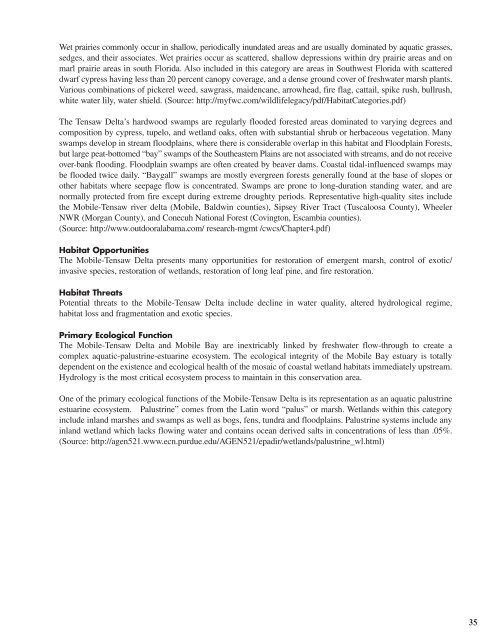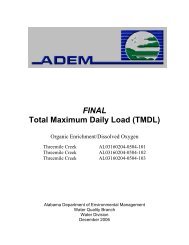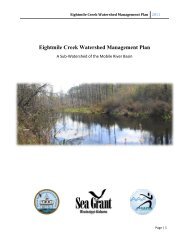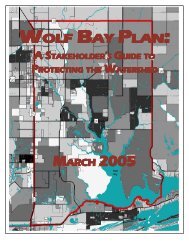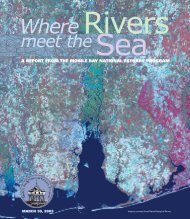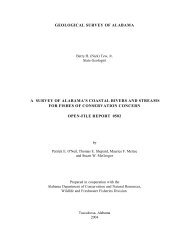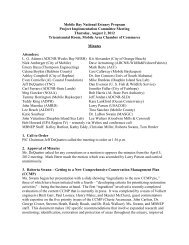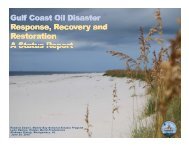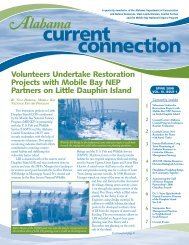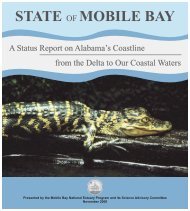<strong>Mobile</strong> DeltaThe <strong>Mobile</strong>-Tensaw Delta conservation area, located in southwest Alabama, is part of the East Gulf <strong>Coastal</strong> Plainecoregion and empties into <strong>Mobile</strong> <strong>Bay</strong>. The Tensaw Delta is defined as the area from the Alabama River cutoffsouthward to the upper end of <strong>Mobile</strong> <strong>Bay</strong> at U.S. Highway 90 within the ten foot contour interval. The Deltais approximately 45 miles long, averages 8 miles wide, and contains 400 square miles of wetland and aquaticecosystems. It drains an area of about 44, 000 square miles including 64% of Alabama and small portions ofGeorgia and Mississippi. The Delta and the adjacent <strong>Mobile</strong> <strong>Bay</strong> estuary compose one of the largest wetlandecosystems in the United States.The Delta comprises an extensive wetland ecosystem dominated by deeply flooded swamp forests, seasonallyflooded bottomland hardwoods, freshwater marshes and various aquatic communities. It is characterized by alarge number of distributary rivers, streams, bayous and creeks which form a maze of waterways.Habitat Strengths/ImportanceAn area of 190,000 acres of the Delta was designated as a <strong>National</strong> Natural Landmark in 1974, and four siteswithin the Delta are also listed on the <strong>National</strong> Register of Historic Places. The <strong>Mobile</strong>-Tensaw River Delta hasrecently been identified by Natural Heritage Program as one of the top priority sites for protection within the EastGulf <strong>Coastal</strong> Plain (EGCP) Ecoregion. As such it is deemed to be of irreplaceable value in protecting the full rangeof biodiversity of the EGCP which stretches from eastern Louisiana across coastal Mississippi and Alabama tosouthwest Georgia and the Florida panhandle.According to the Forever Wild ranking system, the <strong>Mobile</strong>-Tensaw Delta has been identified as one of their toppriorities for protection. The ADCNR Game & Fish Division has also listed the <strong>Mobile</strong>-Tensaw Delta as one oftheir highest priorities for inclusion into the state Wildlife Management Area System. Furthermore, the <strong>Mobile</strong>-Tensaw Delta has been identified in a recent nationwide study to be one of the 15% of small watershed areas inthe U.S. recognized as being critical to conserve the nation’s at-risk fish and mussel species (Master et al, 1998).As such, the <strong>Mobile</strong>-Tensaw Delta is one of 327 watersheds (of the 2,100 in the U.S.) to be deemed as being ofirreplaceable value to conserving populations of all freshwater fish and mussel species at risk in the United States.The Bottomland hardwood forests within the Delta are wetland forests that are composed of a diverse assortmentof hydric hardwoods which occur on the rich alluvial soils of silt and clay deposited along several Panhandle riversincluding the Apalachicola, Choctawhatchee, and Escambia. These communities are characterized by an overstorythat includes water hickory, overcup oak, swamp chestnut oak, river birch, American sycamore, red maple, Floridaelm, bald cypress, blue beech, and swamp ash. (Source: http://myfwc.com/wildlifelegacy/pdf/Habitat Categories.pdf)The Tensaw Delta’s freshwater marshes are wetland communities dominated by a wide assortment of herbaceousplant species growing on sand, clay, marl, and organic soils in areas of variable water depths and inundationregimes. Generally, freshwater marshes occur in deeper, more strongly inundated situations and are characterizedby tall emergents and floating-leaved species. Freshwater marshes occur within flatwoods depressions, alongbroad, shallow lake and river shorelines, and scattered in open areas within hardwood and cypress swamps. Also,other portions of freshwater lakes, rivers, and canals that are dominated by floating-leaved plants such as lotus,spatterdock, duck weed, and water hyacinths are included in this category. Freshwater marshes are commonfeatures of many river deltas, such as the Escambia, Apalachicola and Choctawhatchee, where these rivers dischargeinto estuaries.34
Wet prairies commonly occur in shallow, periodically inundated areas and are usually dominated by aquatic grasses,sedges, and their associates. Wet prairies occur as scattered, shallow depressions within dry prairie areas and onmarl prairie areas in south Florida. Also included in this category are areas in Southwest Florida with scattereddwarf cypress having less than 20 percent canopy coverage, and a dense ground cover of freshwater marsh plants.Various combinations of pickerel weed, sawgrass, maidencane, arrowhead, fire flag, cattail, spike rush, bullrush,white water lily, water shield. (Source: http://myfwc.com/wildlifelegacy/pdf/HabitatCategories.pdf)The Tensaw Delta’s hardwood swamps are regularly flooded forested areas dominated to varying degrees andcomposition by cypress, tupelo, and wetland oaks, often with substantial shrub or herbaceous vegetation. Manyswamps develop in stream floodplains, where there is considerable overlap in this habitat and Floodplain Forests,but large peat-bottomed “bay” swamps of the Southeastern Plains are not associated with streams, and do not receiveover-bank flooding. Floodplain swamps are often created by beaver dams. <strong>Coastal</strong> tidal-influenced swamps maybe flooded twice daily. “<strong>Bay</strong>gall” swamps are mostly evergreen forests generally found at the base of slopes orother habitats where seepage flow is concentrated. Swamps are prone to long-duration standing water, and arenormally protected from fire except during extreme droughty periods. Representative high-quality sites includethe <strong>Mobile</strong>-Tensaw river delta (<strong>Mobile</strong>, Baldwin counties), Sipsey River Tract (Tuscaloosa County), WheelerNWR (Morgan County), and Conecuh <strong>National</strong> Forest (Covington, Escambia counties).(Source: http://www.outdooralabama.com/ research-mgmt /cwcs/Chapter4.pdf)Habitat OpportunitiesThe <strong>Mobile</strong>-Tensaw Delta presents many opportunities for restoration of emergent marsh, control of exotic/invasive species, restoration of wetlands, restoration of long leaf pine, and fire restoration.Habitat ThreatsPotential threats to the <strong>Mobile</strong>-Tensaw Delta include decline in water quality, altered hydrological regime,habitat loss and fragmentation and exotic species.Primary Ecological FunctionThe <strong>Mobile</strong>-Tensaw Delta and <strong>Mobile</strong> <strong>Bay</strong> are inextricably linked by freshwater flow-through to create acomplex aquatic-palustrine-estuarine ecosystem. The ecological integrity of the <strong>Mobile</strong> <strong>Bay</strong> estuary is totallydependent on the existence and ecological health of the mosaic of coastal wetland habitats immediately upstream.Hydrology is the most critical ecosystem process to maintain in this conservation area.One of the primary ecological functions of the <strong>Mobile</strong>-Tensaw Delta is its representation as an aquatic palustrineestuarine ecosystem. Palustrine” comes from the Latin word “palus” or marsh. Wetlands within this categoryinclude inland marshes and swamps as well as bogs, fens, tundra and floodplains. Palustrine systems include anyinland wetland which lacks flowing water and contains ocean derived salts in concentrations of less than .05%.(Source: http://agen521.www.ecn.purdue.edu/AGEN521/epadir/wetlands/palustrine_wl.html)35


